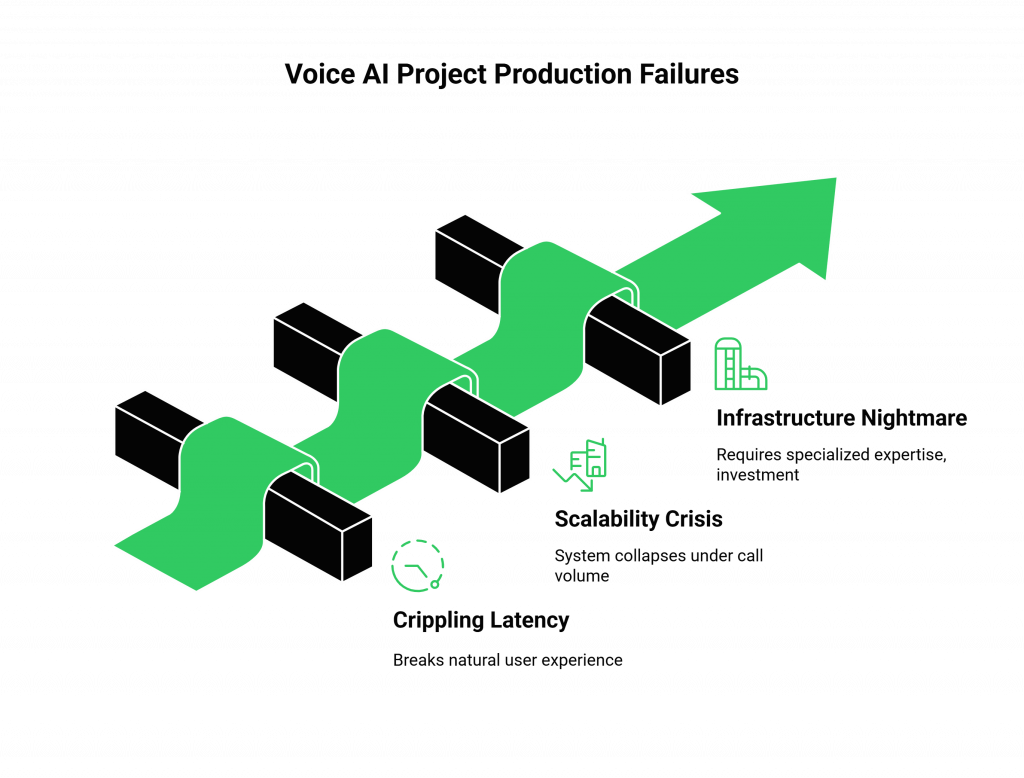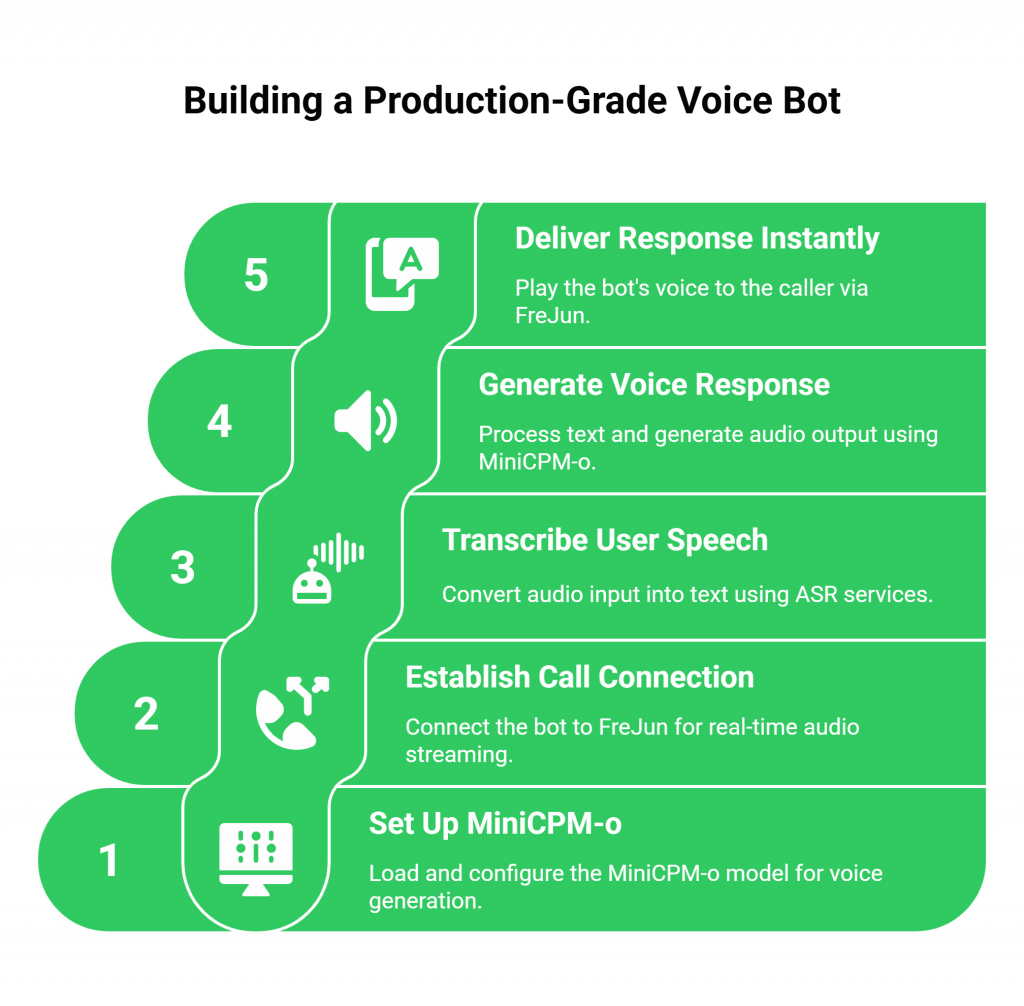For years, automated voice support has been a story of generic, robotic interactions. We’ve all been on the receiving end of a disembodied, monotone voice that lacks any semblance of personality or brand identity. This one-size-fits-all approach has been a major barrier to customer acceptance, making automated systems feel cold and impersonal. To create a truly engaging customer experience, businesses need more than just an intelligent bot; they need a bot with a unique, recognizable voice.
Table of contents
- The Production Wall: Where Voice AI Projects Go Wrong
- FreJun: The Production-Ready Voice for Your Custom AI
- The Core Technology Stack for a Production-Ready Voice Bot
- The Production-Grade MiniCPM Voice Bot Tutorial
- DIY Infrastructure vs. FreJun: A Strategic Comparison
- Best Practices for Optimizing Your MiniCPM Voice Bot
- From Custom Voice to Unforgettable Brand Experience
- Frequently Asked Questions (FAQs)
This is where a new generation of multimodal AI, designed with voice at its core, is changing the game. Models like MiniCPM-o are not just text-based language models with a text-to-speech (TTS) engine bolted on. They are state-of-the-art multimodal systems with built-in, advanced voice capabilities. With features like instruction-to-speech, zero-shot voice cloning, and audio-prompted role-playing, MiniCPM-o makes it possible to create AI agents with truly custom, natural, and expressive voices.
The Production Wall: Where Voice AI Projects Go Wrong
The excitement around a model with native voice cloning and role-playing capabilities is immense. Developers can build impressive demos where the AI can perfectly mimic a reference voice or adopt a specific character. But a massive chasm separates this local demo from a scalable, production-grade system that can handle real phone calls from customers. This is the production wall, and it’s where most voice AI projects fail.

When a business tries to take their demo live, they collide with the brutal complexity of telephony infrastructure. The challenges are significant and often underestimated:
- Crippling Latency: The delay between a caller speaking and the bot responding with its custom-cloned voice is the number one killer of a natural conversation. High latency leads to awkward pauses and a fundamentally broken user experience.
- The Scalability Crisis: A system that works for one call will collapse under the weight of hundreds or thousands of concurrent calls during peak business hours.
- Infrastructure Nightmare: Building and maintaining a resilient, geographically distributed network of telephony carriers, SIP trunks, and real-time media streaming protocols requires highly specialised expertise, significant investment, and considerable time.
This infrastructure problem is the primary reason why so many promising voice AI projects stall, consuming valuable resources on “plumbing” instead of perfecting the AI’s unique voice and personality.
FreJun: The Production-Ready Voice for Your Custom AI
FreJun was created to demolish this production wall. We believe that businesses should be able to leverage the most advanced, voice-native AI models without having to become telecommunications experts. FreJun handles the complex voice infrastructure so you can focus on building your AI.
Our platform serves as the critical bridge between your MiniCPM-o application and the global telephone network. We provide a robust, developer-first API that manages the entire voice layer, from call connection to real-time audio streaming. By abstracting away the complexity of telephony, we enable you to turn your advanced, multimodal model into a powerful, production-ready MiniCPM voice bot.
The Core Technology Stack for a Production-Ready Voice Bot
A modern voice bot is a pipeline of integrated technologies. For a bot powered by MiniCPM-o, a production-ready stack includes:
- Voice Infrastructure (FreJun): The foundational layer that connects your bot to the telephone network, managing the call and streaming audio in real-time.
- Automatic Speech Recognition (ASR): A service to transcribe the caller’s raw audio into text. While MiniCPM-o has audio processing capabilities, a specialize ASR may be used for initial transcription.
- Conversational AI and TTS (MiniCPM-o): The “brain” and “voice” of the operation. The MiniCPM-o model handles both the intelligent response generation and the synthesis of that response into a custom, natural-sounding voice.
The Production-Grade MiniCPM Voice Bot Tutorial
While many online tutorials start with your computer’s microphone, a real business application starts with a customer’s phone call. This guide outlines the pipeline for a production-grade MiniCPM voice bot.

Step 1: Set Up Your MiniCPM-o Model
Before your bot can speak, its brain and vocal cords need to be running.
- How it Works: Load the MiniCPM-o model and tokenizer from the OpenBMB repository using libraries like PyTorch. Configure your system prompts to select the desired mode, whether a stable preset voice (like assistant_female_voice), audio role-playing, or zero-shot voice cloning using a reference audio file.
Step 2: Establish the Call Connection with FreJun
This is where the real-world interaction begins.
- How it Works: A customer dials your business phone number, which is routed through FreJun. Our API establishes the call and immediately begins providing your application with a secure, real-time stream of the caller’s raw voice audio.
Step 3: Transcribe User Speech with ASR
The raw audio stream from FreJun must be converted into text.
- How it Works: You stream the audio from FreJun to your chosen ASR service, which transcribes the speech in real time and returns the text to your application server.
Step 4: Generate a Voice Response with MiniCPM-o
The transcribed text is fed to your MiniCPM-o model.
- How it Works: Your application takes the transcribed text, appends it to the ongoing conversation history, and passes it to the MiniCPM-o model’s chat method. The model processes this context and, based on your initial setup, generates a response directly as an audio output, using the custom voice you’ve defined.
Step 5: Deliver the Response Instantly via FreJun
The final, crucial step is playing the bot’s unique voice to the caller.
- How it Works: You pipe the synthesized audio output from the MiniCPM-o model directly to the FreJun API. Our platform plays this audio to the caller over the phone line with minimal latency, completing the conversational loop and creating a seamless, interactive experience for your MiniCPM voice bot.
DIY Infrastructure vs. FreJun: A Strategic Comparison
As you set out to build a MiniCPM voice bot, you face a critical build-vs-buy decision for your voice infrastructure. The choice will impact your project’s speed, cost, and ultimate success.
| Feature / Aspect | DIY Telephony Infrastructure | FreJun’s Voice Platform |
| Primary Focus | 80% of your resources are spent on complex telephony, network engineering, and latency optimization. | 100% of your resources are focused on building and refining the AI’s unique voice, personality, and conversational skills. |
| Time to Market | Extremely slow (months or years). Requires hiring a team with rare telecom expertise. | Extremely fast (days or weeks). Our developer-first APIs and SDKs abstract away all the complexity. |
| Latency Management | A constant and difficult battle to minimize the conversational delays that make bots feel robotic. | Engineered for low latency. Our entire stack is optimized for the demands of real-time voice AI. |
| Scalability & Reliability | Requires massive capital investment in redundant hardware, carrier contracts, and 24/7 monitoring. | Built-in. Our platform is built on a resilient, high-availability infrastructure designed to scale with your business. |
| Maintenance | You are responsible for managing hardware, software dependencies, carrier relationships, and troubleshooting complex failures. | We provide guaranteed uptime, enterprise-grade security, and dedicated integration support from our team of experts. |
Best Practices for Optimizing Your MiniCPM Voice Bot
Building the pipeline is the first step. To create a truly effective MiniCPM voice bot, follow these best practices:
- Start with Stable Voices: For initial customer support deployments, use the stable default voices provided (assistant_female_voice or assistant_male_voice). These are optimized for reliable performance.
- Master Prompt Engineering: Use the system prompts to clearly define the agent’s role, personality, and constraints. This is your primary tool for guiding its behavior.
- Leverage Voice Cloning for Branding: For a more advanced and branded experience, use the zero-shot voice cloning feature. This allows you to create a unique voice for your company’s AI agent that customers will come to recognize.
- Test in Real-World Scenarios: Move beyond your development environment. Test your agent with real phone calls, diverse accents, and noisy backgrounds to ensure its robustness, especially for voice cloning and role-playing features. This is a critical step for any MiniCPM voice bot.
From Custom Voice to Unforgettable Brand Experience
MiniCPM-o is more than just another large language model; its native, end-to-end voice synthesis and cloning capabilities represent a new frontier in creating personalized, branded AI interactions. This creates an unprecedented opportunity for businesses to build automated agents that are not just intelligent, but also memorable.
By building your MiniCPM voice bot on FreJun’s infrastructure, you make a strategic decision to leapfrog the most significant technical hurdles and focus directly on innovation.
You can harness the full potential of this groundbreaking model, confident it will deliver its unique voice with clarity, reliability, and speed. Stop worrying about telephony and start building the future of your customer experience. This is how you turn a powerful AI model into an unforgettable brand asset.
Further Reading – AI for Sales: Best Tools, Strategies & Benefits
Frequently Asked Questions (FAQs)
MiniCPM-o is a state-of-the-art, open-source multimodal large language model. Its standout feature is its advanced, built-in voice capabilities, including instruction-to-speech, zero-shot voice cloning, and audio-prompted role-playing.
No. FreJun is the specialized voice infrastructure layer. We provide the real-time call management and audio streaming. Our platform is model-agnostic, allowing you to connect to the MiniCPM-o model running on your own infrastructure. This gives you maximum control and flexibility.
The MiniCPM-o model can mimic a voice from a short audio sample without requiring extensive training on that specific voice. This makes it very easy to create a custom voice for your MiniCPM voice bot.
In most cases, no. MiniCPM-o has its own powerful, integrated text-to-speech features. The model can generate audio directly, which simplifies the pipeline and can reduce latency. You would only need an external TTS if you had a specific requirement that the built-in one could not meet.
A business application needs to handle real phone calls from the public telephone network, scale to many concurrent users, and operate with high reliability and low latency. A microphone-based demo cannot meet any of these production requirements, which is why a voice infrastructure platform like FreJun is necessary.
